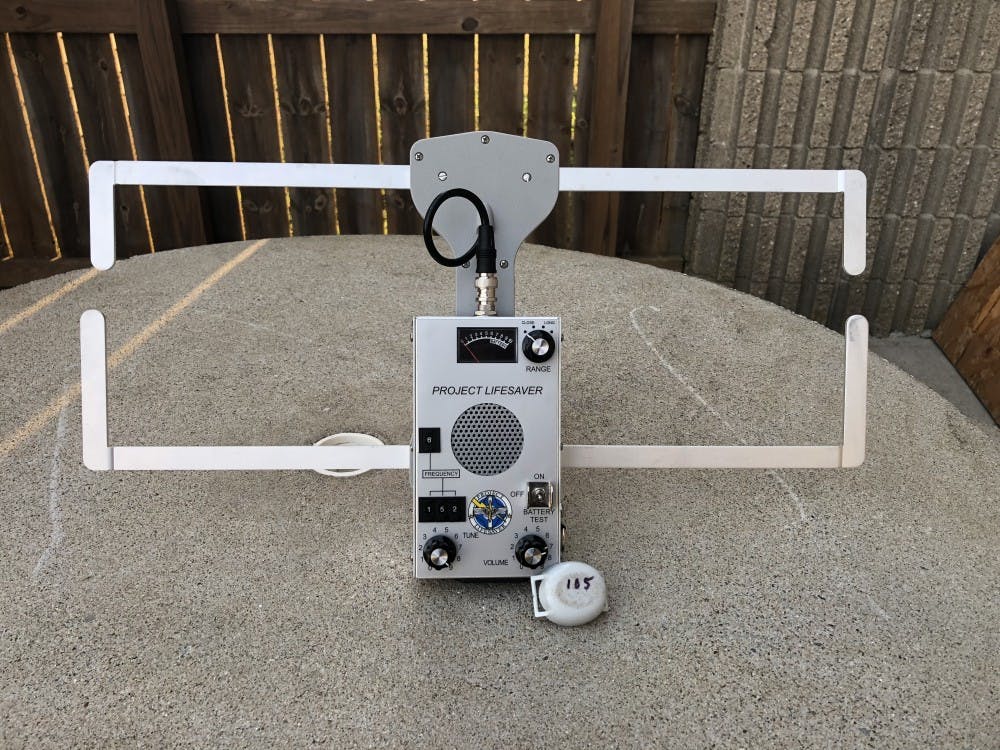About six years ago, Carrie Shabahrami's daughter, who has autism, was lost in Monroe County. She was found, but Shabahrami wanted to find a way to protect her daughter.
Paul Ford, Van Buren Township Fire Department Lt., said Monroe County Sheriff's Office gave Shabahrami his contact information because he had Project Lifesaver equipment, which is used to track people who wander.
Shabahrami's daughter became the county's first client. Ford said about 45 county citizens are enrolled in the program now.
Clients in Project Lifesaver must have a tendency to wander, and they wear a band attached to a white, yellow or blue case with a small transmitting device locked inside. It can only be removed by cutting the band, according to the program's website. If a user becomes lost, a trained official will use a frequency receiving device to track the signal.
Kyrianna Hoffses, Project Lifesaver's director of media and public relations, said the now worldwide program was founded in April 1999 by Gene Saunders, former volunteer chief of search and rescue for Chesapeake, Virginia, Sheriff's Department. Hoffses said Project Lifesaver began when frequency signals used to track wildlife inspired Saunders to think of ways he could implement the technology on Alzheimer's patients.
"We can estimate that at any given time there are 70,000 to 75,000 clients," Hoffses said.
Hoffses said Project Lifesaver's mission expanded to include all people with cognitive disorders, such as autism or Down syndrome.
"These populations are not getting smaller, they're getting larger," Saunders said. "These incidents are increasing."
Saunders said Project Lifesaver has previously conferred with high functioning adults with autism, early stage Alzheimer's patients and the caregivers of all types of clients when designing the device.
Van Buren Township Fire Department is one of the nearly 1,600 agencies trained to use Project Lifesaver.
The transmitter receiver can pick up a user's individual frequency signal from a mile away, Ford said. The receiver beeps when pointed in the direction of the signal, and the beeps become louder as one nears the transmitter.
Hoffses said there is a misconception that the transmitters actively track location, but the truth is they only track when the receiver pings an individual frequency.
"90% of people located by member agencies are located with ground searching," Saunders said.
Ford said Barbara Beland brought Project Lifesaver to Monroe County as a MCSO Deputy in search and rescue. Beland ran the program, and Ford said when she retired, she asked him if he could store the equipment.
Then Carrie Shabahrami's daughter became lost.
Ford said Shabahrami's enthusiasm inspired him to complete Project Lifesaver training and reinstate the program in Monroe County. Shabahrami led fundraising efforts and became his partner on the project before later moving to a different state.
Clients in Monroe County don’t pay to enroll in Project Lifesaver, Ford said. They strictly run off of donations, and Ford has won a few small grants.
"Our belief from the start has been that when people have dementia, autism, Alzheimer’s, Down syndrome or any number of cognitive reasons, they are medical billed to death," Ford said. "I want people to be able to use this."
Ford said each transmitter bracelet costs about $300, and each receiver costs $1,100. Receivers are stationed in six fire departments across Monroe County. He also keeps one in his truck.
Hoffses said some counties have to charge a fee for enrollment, and people may be put on waitlists for the program. If a person wants to enroll but his or her county does not offer the program, Project Lifesaver offers the equipment for purchase on their site.
Ford said he prefers for users, especially young ones, to wear the device on their ankle rather than wrist. He said a sock can be pulled up over the device to conceal it.
Some clients in Monroe County prioritize style while wearing the device. Ford said one boy has attached a small, flat clock face to the top of the transmitter case, and that he uses it as his watch. Another young girl has added stickers to her case.
Hoffses said wearers are often profiled as criminals. Project Lifesaver tells caregivers the chance of profiling can be high and encourages them to be patient and explain the program, she said.
"There is unfortunately a lot of ignorance in the world," Hoffses said. "Safety is more important than people's judgements."
The wearer of the device does not have to consent, and Hoffses said that is because they are not usually of sound mind.
Saunders said it is policy at Project Lifesaver to obtain reinformed consent when a wearer turns 18 and becomes their own guardian. However, when asked about Monroe County's process Ford told the Indiana Daily Student it doesn't matter at that point because the user has probably worn the device for so long.
Coming soon: Neurodiversity, Alzheimer's advocates share their opinions on Project Lifesaver.




